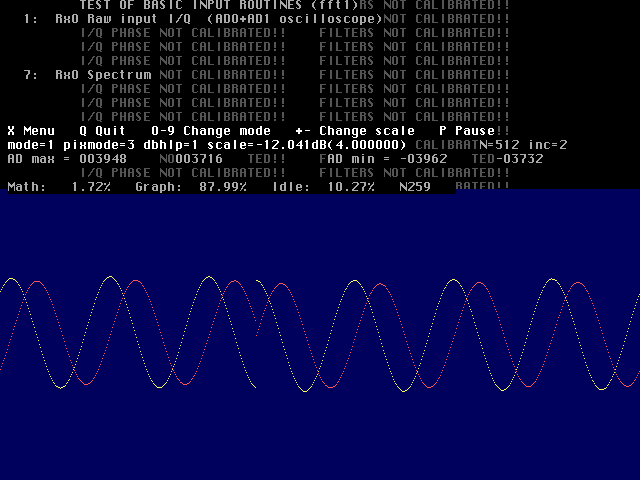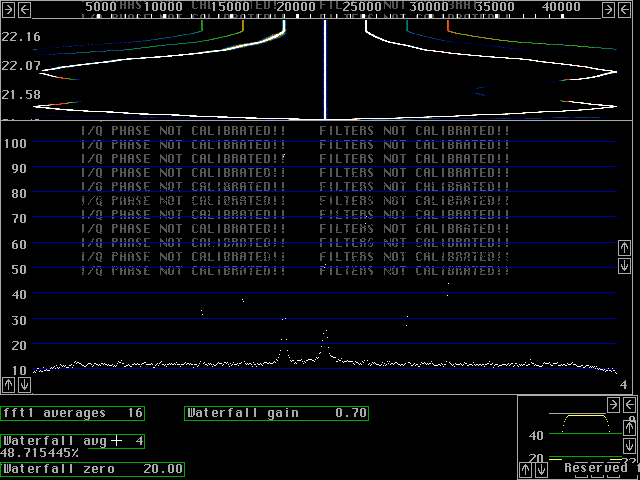Hardware detailsThe detailed schematic diagram for the test unit used to record the screen dumps on this page is shown in figure 1. Note that the mixers are NOT terminated in 50 ohms at the IF frequency. This way the output voltage is increased by 10dB compared to what is obtained with a 50 ohm resistor from the IF port to ground. The IM products do not increase more than the desired signal, so one might say that leaving the output unterminated does not degrade linearity. Now that is not a fair statement. One could also argue that for the same output level the IM products are greatly reduced since the same output is obtained with a 10dB smaller input signal.The 100 ohm resistor and the 1000pF capacitor on the IF (audio) output is just a safety precaution to reduce RF levels sent into the audio board. The 100 ohm resistors on the output is also a safety precaution when using this unit backwards as an upconverter from audio to RF. I do not think there will be any disadvantage in connecting the IF port of the mixer directly to the computer A/D board. The local oscillator is connected to the mixers through 50 ohm resistors for the input to see 50 ohms. The SBL-1 mixers operate with a LO power level of 0dBm. By use of a power divider one can avoid the 3dB loss caused by the resistors but the need to feed the LO input with 6dBm rather than by 3dBm is not worth the trouble. The 100 ohm resistor on the lower mixer RF port is to make balance between the channels. It is essential that the quarter wave line is loaded by 50 ohms because otherwise the cable will transform the voltage. These mixers nominally are nominally 50 ohms but with the specified SWR of 1.5 at the LO port the need for some adjustment is not unexpected. All measurements on the dual SBL-1 mixer are made on 144MHz although the circuit can be used for any frequency between 1 and 500MHz according to SBL-1 specifications.
|

|
Adjusting balance is very easy but not necessaryWith the mixer of fig. 1. connected directly to the line input of a Soundblaster SB16 mounted in a Pentium MMX 200MHz a complete radio is obtained. As in all direct conversion receivers very good phase and amplitude balance is required. Amplitude may be tuned with the 100 ohm resistor and the phase may be tuned by a LC circuit parallell to this resistor.
|

|
When used with the Linux PC radio this tuning is very easy by use of the builtin oscilloscope in "F = HARDWARE TEST MODE" The unit according to fig. 1 produces the screen of fig.2 without any adjustment at all when a signal generator of fixed frequency is connected to the RF input. The amplitude of the yellow track is clearly grater than the amplitude of the red track. Tuning the resistor for much better balance would be easy using this screen and setting the phase to somewhere nearly right also. Without worrying at all about the hardware imperfections, using the receiver without any adjustments at all, the spectrum looks like shown in fig. 3
|

|
There is no reason to fine tune the hardware since the fine tuning can equally well be done in the computer. In this particular case, using no high Q anti alias filter, calibrating in software is a marginal advantage. When using external very steep filters it is hopeless to get good performance directly from hardware - that is why the calibration routines are included. Now, since they are there they can be used in this simple case as well with no disadvantage.
|

|
Performance of the simple direct conversion radioFig. 4 shows the screen with the strongest permissible undesired signal causing spurs around -50dB. The input signal level is about -15dBm. Translated to third order IP this corresponds to about 10dBm.It will not be possible to connect the antenna directly to the RF input for several reasons. Firstly the mixers are sensitive to signals at overtones of the LO. It is necessary to use a preamplifier that will supress the overtone frequencies adequately. The LO may have sub harmonics or other spurs at frequencies far from the desired frequency. For these reasons - and for other reasons as well it is desireable to use a narrow filter for the desired frequency band. The noise figure of this direct conversion radio is no better than permitted by the noise floor of the Soundblaster board. It is around 45dB, certainly not impressive at all!! To use this unit as a radio receiver on 144MHz one might add a low noise amplifier, a cavity filter followed by a second amplifier for a total gain of about 65dB. Then the noise figure will be ok but the noise floor will be raised by 15dB so the strongest acceptable undesired signal will be only 65dB above the noise floor. With 65dB gain in front of this mixer the third order IP will be around -55dBm, not impressive at all, but certainly useful in good (quiet) locations. Much better than using high gain on the RF side is to add a low noise audio amplifier. Simple op-amps like RC4136 can be used to amplify the audio signal by about 20 dB without lifting the noise floor. With such an audio amplifier 45dB of RF gain will be enough and the third order IP will be somewhere around -30dBm. The strongest undesired signal this receiver can accept is about -50Bm, that is the level causing saturation of the Soundblaster. There are obvious improvements to this simple radio. An optimised audio amplifier will allow a noise figure below 10dB at the mixer input but to not add any significant amount of noise from the audio amplifier it will be optimum to use slightly less gain for a noise figure around 16 dB at the mixer input. High level mixers will tolerate more signal before they saturate but it is extremely difficult to make local oscillators with low enough sideband noise on 144MHz. By use of a low pass filter between the mixer and the audio amplifier one can get first class dynamic range performance for signals outside the +/- 22kHz frequency range seen by the A/D converters.
Simple high performance rig for EME expeditionsInspired by a question from Dom, F6DRO about using a lap top computer for software radio I would suggest this very simple but extremely efficient equipment for EME expeditions.A complete 144MHz station. Low weight and absolute top performance can be designed as follows.
1) A X-tal oscillator tunable +/-10kHz or so. Running always
and used for both transmit and receive.
It should be possible to power all of this from a (big) car battery sourced locally together with something to charge it (50A). The key down power might be 2kW while key up or receive mode will be just a few W.
|